- EUR/USD surges toward 1.0350 as US President Trump delays tariffs on Canada and Mexico for 30 days.
- Trump remains firm on imposing tariffs on China.
- The ECB is projected to implement three more rate cuts this year.
EUR/USD recovers from its intraday low of 1.0270, climbing toward 1.0350 during Tuesday's European session. The pair finds support as US President Donald Trump's decision to delay tariffs on Canada and Mexico reduces demand for the safe-haven US Dollar (USD).
The US Dollar Index (DXY), which measures the USD against a basket of six major currencies, surrenders earlier gains and trades at 108.44, nearing Monday's low of 108.40.
Trump's decision to postpone tariffs on North American trade partners follows their agreement to collaborate on stopping the flow of fentanyl. However, his proposed 10% tariffs on China remain in place, with the potential for further escalation. "China hopefully is going to stop sending us fentanyl, and if they're not, the tariffs are going to go substantially higher" ,Trump stated.
China responded swiftly with countermeasures, imposing a 15% tariff on coal and liquefied natural gas (LNG), along with a 10% tariff on crude oil, farm equipment, and certain automobiles. This targeted retaliation suggests the trade war will remain focused on US-China relations rather than expanding globally, reducing the appeal of safe-haven assets.
The US Dollar's movement this week will be shaped by a series of key labor market indicators, including JOLTS Job Openings, ADP Employment Change, Nonfarm Payrolls (NFP), and the US ISM Services PMI.
These reports will influence market expectations regarding the Federal Reserve's (Fed) monetary policy trajectory for the year. Currently, the Fed remains in a wait-and-see approach on interest rates, requiring "real progress" in inflation or signs of labor market weakness before making adjustments.
Daily Digest Market Movers: EUR/USD Rebounds as Safe-Haven Demand for US Dollar Weakens
- EUR/USD recovers as USD softens, but Eurozone uncertainty persists - The pair's rebound is driven by weakness in the US Dollar, though concerns remain over the Eurozone's potential exposure to US tariff threats. Over the weekend, President Trump reiterated his intention to impose tariffs on the Eurozone, accusing it of unfair trade practices. He claimed that Europe "takes almost nothing" from the US while the US imports extensively from the region, specifically targeting the auto and agricultural sectors.
- EU vows to retaliate against potential US tariffs - French President Emmanuel Macron responded to Trump's threats by asserting that the European Union (EU) would defend its economic interests. "If our commercial interests are attacked, Europe, as a true power, will have to make itself respected and therefore react," Macron stated, as reported by The Guardian.
- Market experts warn of economic risks from a US-EU trade war - Analysts highlight that trade and investment ties between the US and Europe are among the largest globally. A trade war between them could fuel inflation and disrupt economic stability. A surge in Eurozone inflation would also complicate the European Central Bank's (ECB) ongoing policy easing, which is focused on ensuring inflation returns to its 2% target.
- ECB remains committed to rate cuts - The central bank recently lowered its Deposit Facility Rate by 25 basis points (bps) to 2.75%, reinforcing its stance on monetary easing. Markets anticipate at least three more rate cuts by the summer, reflecting confidence in the ECB's policy trajectory.
Technical Analysis: EUR/USD Recovers but Struggles to Reclaim 20-Day EMA

EUR/USD rebounds from a three-week low of 1.0210, climbing toward 1.0350 on Tuesday. However, the pair remains below the 20-day and 50-day Exponential Moving Averages (EMAs), positioned at 1.0379 and 1.0439, respectively, signaling a continued bearish trend.
The 14-day Relative Strength Index (RSI) hovers above 40.00. A break below this level could reinforce bearish momentum.
On the downside, key support levels include the January 13 low at 1.0177 and the psychological round figure of 1.0100. On the upside, the 1.0500 level serves as a crucial resistance barrier for Euro buyers.





